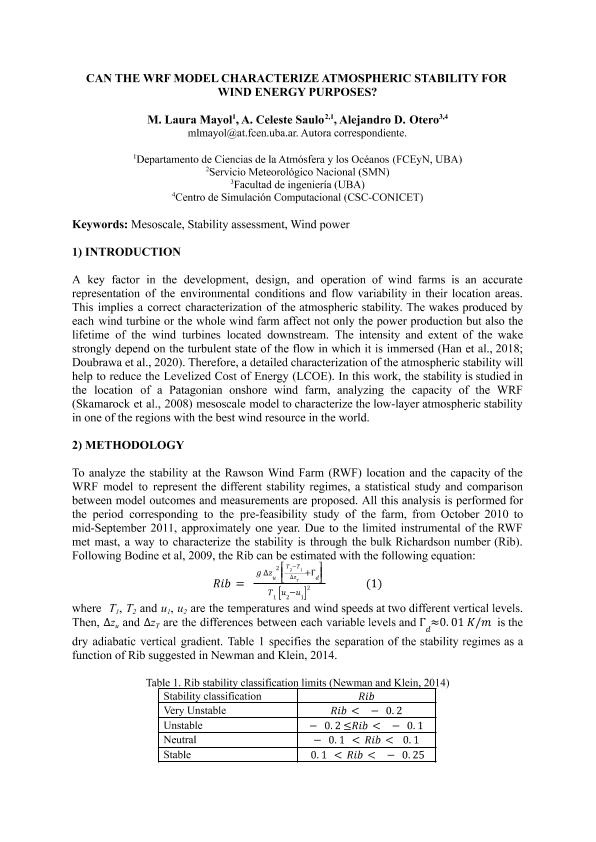Mostrar el registro sencillo del ítem
dc.contributor.author
Mayol, María Laura

dc.contributor.author
Saulo, Andrea Celeste

dc.contributor.author
Otero, Alejandro Daniel

dc.date.available
2023-09-07T17:52:45Z
dc.date.issued
2023
dc.identifier.citation
Can the wrf model characterize atmospheric stability for wind energy purposes?; XIV Congreso Argentino de Meteorología; Buenos Aires; Argentina; 2022; 1-3
dc.identifier.uri
http://hdl.handle.net/11336/210850
dc.description.abstract
To foster energy transition, renewable energies need to achieve their full potential. One phenomena greatly impacting power production in wind energy is the wake production behind each wind turbine or entire farms. These wake regions are strongly modulated by low-layer atmospheric stability. In this work, the capability of the WRF mesoscale model to characterize the stability in the Rawson Wind Farm location is addressed. Through a dynamical downscaling from ERA5 data, the WRF outcomes are used to estimate the stability parameter RiB, which is compared to the one computed from measurements. A great similarity emerges from the analysis, in statistical terms, between the stability conditions estimated from the observations and those resulting from the simulations. These results encourage the use of mesoscale models to obtain a more detailed description of the low-layer flow and therefore reduce the uncertainties linked to the environmental conditions that affect a wind farm.
dc.format
application/pdf
dc.language.iso
eng
dc.publisher
Centro Argentino de Meteorólogos

dc.rights
info:eu-repo/semantics/openAccess
dc.rights.uri
https://creativecommons.org/licenses/by-nc-sa/2.5/ar/
dc.subject
Mesoscale
dc.subject
Stability assessment
dc.subject
Wind power
dc.subject.classification
Meteorología y Ciencias Atmosféricas

dc.subject.classification
Ciencias de la Tierra y relacionadas con el Medio Ambiente

dc.subject.classification
CIENCIAS NATURALES Y EXACTAS

dc.title
Can the wrf model characterize atmospheric stability for wind energy purposes?
dc.type
info:eu-repo/semantics/publishedVersion
dc.type
info:eu-repo/semantics/conferenceObject
dc.type
info:ar-repo/semantics/documento de conferencia
dc.date.updated
2023-08-28T11:28:54Z
dc.journal.pagination
1-3
dc.journal.pais
Argentina

dc.journal.ciudad
Buenos Aires
dc.description.fil
Fil: Mayol, María Laura. Consejo Nacional de Investigaciones Científicas y Técnicas; Argentina. Universidad de Buenos Aires. Facultad de Ciencias Exactas y Naturales. Departamento de Ciencias de la Atmósfera y los Océanos; Argentina
dc.description.fil
Fil: Saulo, Andrea Celeste. Universidad de Buenos Aires. Facultad de Ciencias Exactas y Naturales. Departamento de Ciencias de la Atmósfera y los Océanos; Argentina. Ministerio de Defensa. Secretaria de Planeamiento. Servicio Meteorológico Nacional; Argentina. Consejo Nacional de Investigaciones Científicas y Técnicas; Argentina
dc.description.fil
Fil: Otero, Alejandro Daniel. Consejo Nacional de Investigaciones Científicas y Técnicas. Oficina de Coordinación Administrativa Parque Centenario. Centro de Simulación Computacional para Aplicaciones Tecnológicas; Argentina
dc.relation.alternativeid
info:eu-repo/semantics/altIdentifier/url/http://cenamet.org.ar/congremet/wp-content/uploads/2023/02/LibroActas_compressed.pdf
dc.conicet.rol
Autor

dc.conicet.rol
Autor

dc.conicet.rol
Autor

dc.coverage
Internacional
dc.type.subtype
Congreso
dc.description.nombreEvento
XIV Congreso Argentino de Meteorología
dc.date.evento
2022-11-07
dc.description.ciudadEvento
Buenos Aires
dc.description.paisEvento
Argentina

dc.type.publicacion
Book
dc.description.institucionOrganizadora
Centro Argentino de Meteorólogos
dc.source.libro
Libro de resúmenes extendidos: XIV Congreso Argentino de Meteorología
dc.date.eventoHasta
2022-11-11
dc.type
Congreso
Archivos asociados
